Safety Ideas
by Jude Turczynski
Perhaps more important than your paddle and as important as your PFD, is a convenient high quality leash. You can forget your paddle, but don't forget your leash!
Leashes:
In colder waters, if your canoe/surfski is blown one inch beyond your reach, you could die within an hour from exposure while wearing your life jacket. There are a few stories "floating around" Northern California concerning canoes and surf skis blown from paddlers who were alone or forgotten behind the pack during workouts. Luckily, all of the stories have happy endings, although heroic.
I cannot stress enough the importance of using some sort of leash that ultimately connects you to the boat...No matter if it's glassy out or if it's storming. The leash will keep the boat at your reach, which also means that it will keep you close to everything that might keep you alive. Staying with your boat makes it possible to continue enjoying your workout or race. Staying with your boat makes it possible to use your emergency gear. Staying with your boat in an emergency makes it easier for rescue people to spot you on the water. All this talk about leashes might suggest, "the more the better" but it's not a good idea to use two leashes on one person, one for your boat and another for your paddle, too many leashes WILL kill you. Don't allow the leash to tangle around your legs and body. If you begin to get tangled, remove the leash from your body or untwist it from yourself right away.
When paddling a "Tandem" canoe or surf ski (two person craft) in rough or windy conditions, it's a good idea for each person to be leashed. I've heard of situations where the one person leashed to the Tandem was able to remount, but was unable to paddle the craft back up wind to the other person that had not been leashed. Again, all happy endings "so far" but long scary Ocean swims could've been avoided.
When selecting a leash for an Outrigger Canoe, you want one with a quick release system or Velcro enclosure where the leash attaches to your body. There's really no good way to attach a leash to a canoe paddle. The leash can attach to your ankle, upper calf, waist or where ever...excluding your neck. The other end of the leash can attach to the front iako, or rear iako, or a loop on the deck. You can use a surfboard leash, but they usually have an uncoiled cord that can drag in the water. Boogie board leashes can work but the cords on those are usually too short to stretch close enough to the bow if you should try to swim around the canoe.. It's best to buy a canoe leash from an Outrigger Canoe or surfski supplier. You'll find excellent leashes in the "Shopping" section of our HUKI website.
When using an ankle or knee (upper calf) leash on an outrigger canoe, you will find that it's best attached to one leg or the other depending on how and where you most often remount your canoe. This way, you won't tangle when you climb back on from the right side (side that you fell in from) or the left side if you often remount from the ama side. Most people find that they don't need to swim around the bow to the ama side of the canoe, in order to climb back on. Even in rough conditions, most people just get on from the side that they fell in from. Surf Ski paddlers tend to get their legs tangled more often than canoe paddlers, because they can fall off multiple times while trying to remount, getting twisted with every turn. In any case, learning to use a leash safely takes practice and thought. Memorize "where" the pull tab is located so you can remove it quickly in a pinch, and always attach it with the pull tab in the same location and direction so you don't have to figure it out while drowning.
When a surf ski gets away from you..."Oh #@*$!," is the first thing that comes from your mouth. Some surf ski paddlers tell stories about their surf ski "tumbling" away from them at high speed on the water. I personally have seen this, my own tumbling ski having been licked up into the air by a wave as it spun fast like a circus trick. In lighter winds and small waves, it'll just skid along a little faster than you can swim. It might as well be moving as fast as a jet plane. Swimming with one hand, your paddle in the other hand, chasing after your boat with loose clothing and PFD slowing you down...it's ugly.

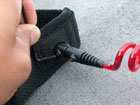
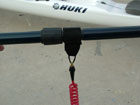
Above:Removing the HUKI leash "leg loop" with an Allen wrench to expose the brass eyelet and set up the leash as a kayak-paddle leash.

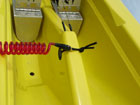
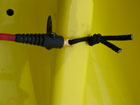
Attachment points on a HUKI ski for paddle leash or leg leash.
When using a leash with a surfski, it's often best to attach the leash to the paddle. Most people never let go of their paddle when they fall off, so if the boat is tied to the paddle, you've got the boat. Should you let go, the attached paddle "might" slow the departure of your ski...maybe...maybe not. Coiled "paddle leashes" seldom wrap around your legs because they stay as short as possible, but when they do tangle...they're tangled real good. Some ski paddlers attach the leash to their ankle or calf, these leashes often tangle around both of your legs, especially if you fall off repeatedly while trying to remount...This could needlessly end your life. If you memorize the location of the "quick release" pull tab found on most ankle or calf leashes, you "might" reduce your chances of tangling, but you then increase the chance that your ski will be blown away while attempting your next remount. The HUKI leash can be used as a leg leash or a paddle leash. Just remove (with an allen wrench) the larger leg cuff to expose the brass eye end and tie that end to your boat, wrap the "small" velcro enclosure around your paddle shaft.
Personal Floatation Devices:
Wearing your PFD or Life Jacket is probably the most obvious way to protect yourself. Bungeeing it to the boat is a dangerous practice, all be it legal in most States of the U.S and in other countries. Many individual Outrigger paddlers in Hawaii don't own a PFD, nor do their racing regulations require life jackets to be on the canoes and surf skis. In other places where colder waters are found, paddlers are often required by law to keep them on their craft. Many paddlers wear their PFD when they're alone or when they get separated from the pack. Most, tie their PFD to the boat where it usually stays, even when they huli (turn over). I can not stress enough, how important it is for you to wear your PFD at all times, since it is your last line of defense against DEATH. If everything else fails, but your life jacket...You still have a chance. When looking for a PFD, buy one that is not restrictive of your paddling movements and that is as compact and light as possible. There are some very nice inflatable PFDs that are also very light and offer little wind resistance. If you're comfortable in your PFD, you'll more likely choose to wear it instead of bungee it down to the deck.
Paddling Clothing:
You must dress to swim.
In many parts of the world, it may turn out that a tight top and shorts are the most that you should wear. It's best to choose shorts that don't soak up much water and are not baggy ... that won't hold a lot of water when swimming. The same with your choice of a top. In Hawaii and other warm places, the water temps and air temps don't require much clothing, so don't wear much. In warm waters, a loose fitting cotton top and shorts could make a long swim difficult and slow. In other parts of the world, cold water and air may require that you wear a lot of neoprene and/or other tight fitting weather ready gear. The clothing will effect your ability to paddle and swim efficiently, but it might keep you alive long enough to swim for your boat or the shore if nothing else works right. Loose fitting watertight tops and pants work fine if you're in the water for only a few moments, but they fill with water during a long swim and you have to drag all that with every miserable stroke in a swim for your life.
Packing for safety:
Sky flares and orange smoke are very cheap, light weight and water proof. You can buy these kinds of items at most boating stores. They can be contained within a fanny pack along with a small tow rope. None of these things will do any good if they're bungee'd to the boat, and that boat gets away from you.
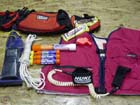
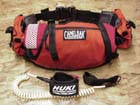
Since sky flares stay up for only a few seconds, you might need to carry three...they can be quite entertaining. Orange smoke is a good, long lasting attention getter. These sticks produce enough thick orange smoke to choke you to death if you don't drown. You'll only need one.
There are several types of "Signal Whistles" available at your local Marine Supply store. Anyone of them would be sufficient to catch the attention of your paddling buddies or a passing boater within ear shot.
A tow rope is a simple, light and versatile device that can be used for so many unanticipated situations. 1/4 inch nylon twine doesn't absorb water and it floats. 25 feet can be used for a tow rope. On Outrigger canoes, tie one end to the front iako, do a loop around the nose (to guide the canoe), and find someone to pull you across the finish line. Surf Skis can be tied at the steering cables or leash loop or lock hole, then looped around the nose and dragged front first. Surf skis can also be tied around the hull just in front of the rudder and dragged tail first, but I don't recommend this unless it's just too rough to turn the ski around AND you can keep the rudder from dragging through the water.
A small hand held VHF Marine radio can be a good thing for coastal cruising and touring. It may be a little too heavy and bulky for racing, but with a range of up to 20 miles, it's uses are obvious. There are several models of "submersible" mini VHF marine band two way radios on the market these days, they weigh nothing and don't require a license to operate in the US. Some nations require a license that is easy to obtain.
At a SF Bay kayak race, I once loaned my safety pack to a first time racer who looked like he might need it more than I...He huli'd far from shore and was unable to get back on the canoe in the rough water. The leash kept the canoe next to him so he could retrieve the PFD and put it on. He summoned the safety boat with the whistle, tied his canoe to the power boat with the tow rope and made it back without loosing anything...including his life. These safety items can be carried on the 6 person canoes as well as the small canoes and surf skis.
Think!
Make conscious choices and decisions. Don't be a victim of circumstance. Every time you head out on the water, remember your leash, consider what conditions are possible out there and what you're prepared to face on that day. Take note of the safety gear your've got with you and how you'd make use of it in a bad situation. When you come across conditions that look challenging, consider your own ability to remount your ski or canoe in those conditions...Unless you're going out into those conditions for the purpose of learning to remount and to deal with it while you're with other people as a safety net, you are taking obvious risks. Try to remount from the upwind side of your ski or canoe so that your boat won't be blown over top of your legs and chest, making it difficult to pull yourself up and on. Every time you notice a change in the conditions, re-evaluate your situation. Every time you notice a new distance between yourself and your fellow paddlers, re-evaluate your situation. Never allow yourself to become complacent in the fact that you've never had a close call in big conditions, self confidence does not mean safe. Be concerned about yourself and your fellow paddlers.
We not only have a responsibility to ourselves and our families to stay alive, but we each represent this sport, each time we go out on the water.